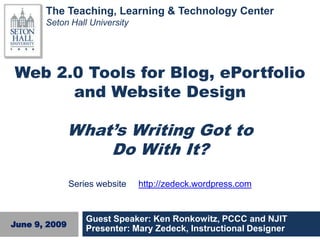
Redefining Universities
- 1. The Teaching, Learning & Technology Center Seton Hall University Web 2.0 Tools for Blog, ePortfolio and Website Design Title What’s Writing Got to Do With It? Series website http://zedeck.wordpress.com Guest Speaker: Ken Ronkowitz, PCCC and NJIT June 9, 2009 Presenter: Mary Zedeck, Instructional Designer
- 2. The Teaching, Learning & Technology Center Seton Hall University Redefining: Universities, How We Teach Title and Learn June 9, 2009 Ken Ronkowitz, PCCC and NJIT
- 4. What Is Being Redefined? 1. Writing 2. Reading 3. Literacy 4. Publishing 5. Ownership/IP/Copyright 6. Research Are WE redefining these things, 7. Privacy or are they being redefined without our participation? 8. Class hours
- 5. Writing What is formal writing? What is informal writing? I think we all agree that a research paper fits the former, and that student lecture notes is the latter, but what about discussion board postings, blog posts, collaborative documents… IM & texting is not writing; it’s conversation Self-sponsored writing Is the essay dying? endoftheessay.wikispaces.com
- 6. Formal and Informal Writing Research paper Student lecture notes Email Blog posts Discussion boards & comments A collaborative document Twitter Presentation ―script‖
- 7. Reading If a student listens to an audiobook, is that reading? Can watching a video presentation take the place of a quot;readingquot; for a class? 75% of time spent online is ―reading‖ But it’s not the ―right kind‖ of reading
- 8. Literacy Media literacy 1960s Digital literacy 1980s Web literacy 1990s What does it mean to be literate if reading and writing are changed? Writing/reading with links, images, video, collaboration, dynamic content, social networking, user-interfaces… The digital revolution will not be televised. See also quot;Literacy? Which One?quot; and quot;NCTE's New Literacies― on Serendipity35
- 9. Publishing If I publish a blog post that is hit (read) by 50,000 people, how different is that from publishing that same text in a magazine that has 50,000 subscribers (readers)? What opportunities did you have as an undergrad to ―publish‖ your work versus a student today? Should online publishing count towards promotion & tenure with the same weight as traditional paper publication?
- 10. Old Media & New Media Gannett should have invented the Huffington Post NBC should have invented YouTube Sony should invented iPods and iTunes Yellow Pages (or any newspaper syndicate) should have developed Craig’s List. ATT should have developed Twitter Fight to preserve journalism, not an old model. SCHOOLS should have developed _________ and if they don’t change, then ___________________
- 11. Ownership, Intellectual Property, Copyright, Fair Use Who owns a collaborative web page? Who wrote a wiki article? How is the open everything movement changing these areas? What is copyleft? Does a Creative Commons license actually protect a work? We say we want students to collaborate (and the quot;real worldquot; of employment tells us it is an essential skill), but do we encourage it, or do we fear it as a kind of cheating and plagiarism?
- 12. My blog, Serendipity35, uses the Creative Commons Attribution- Noncommercial-Share Alike 3.0 Unported http://creativecommons.org/licenses/by-nc-sa/3.0/ You are free: to Share — to copy, distribute and transmit the work to Remix — to adapt the work Under the following conditions: Attribution — You must attribute the work in the manner specified by the author or licensor (but not in any way that suggests that they endorse you or your use of the work). What does quot;Attribute this workquot; mean? The page you came from contained embedded licensing metadata, including how the creator wishes to be attributed for re-use. You can use the HTML here to cite the work. Doing so will also include metadata on your page so that others can find the original work as well. Noncommercial — You may not use this work for commercial purposes. Share Alike — If you alter, transform, or build upon this work, you may distribute the resulting work only under the same or similar license to this one.
- 13. Center for the Study of the Public Domain http://www.law.duke.edu/cspd/
- 14. Research Redefining not only the way we do it (digitized primary sources LoC…) but the way we publish it (online) and use it (see copyleft) If I set up RSS feeds to pull content into my reader, am I doing research? Is an RSS feed a research assistant?
- 15. Privacy Privacy, especially online, has a new meaning. How much of you is online? How much have you deliberately shared and how much is just there? How private is your classroom, your content, your students' work? ―walled gardens‖ like Blackboard are less the norm Facebook ―friends‖ & Twitter followers Assumptions of privacy (cell phone conversations)
- 16. Class Hours The meaning of quot;work hoursquot; expanded starting with the telephone, then with email and again in our age of the Blackberry, virtual workspaces and more. It has also happened to quot;class hours.quot; A decade ago, the only teachers really using course management systems were those teaching at a distance to quot;online students.quot; Now, every student is an online student and many teachers are using a CMS, blogs, social networks, wikis and other tools to continue the classroom discussion and activities beyond the 3 credit hours listed in the catalog. How many hours is now expected of a student and an instructor for a 3 credit course?
- 17. The Web was a push technology. Web 2.0 is pull technology.
- 18. Time’s Wingèd Technology Chariot 30 YEARS – GETTING THE MOBILE computers in the NEWS PHONES classroom TV 60% Using only a cell 20 YEARS - NET 13% 20% Internet NEWSPAPERS Only a land line 10 YEARS – 9% 17% laptops, tablets, Twitter etc. 1% IM, Blackboard Using both 17% remaining? 5 YEARS – 83% Google, No news! MySpace, Facebook, Twitter
- 19. The Future of Blogging Educators have already missed some opportunities for using blogs…. Redefining Blogging (especially commercial applications) Tumblelogs ronk.tumblr.com Microblogging (short posts using Twitter et al) Moblogging (via mobile phones)
